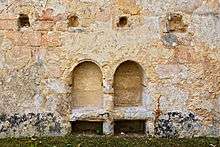Abbey of Saint-Cybard
The Abbey of Saint-Cybard was a Benedictine monastery located just outside the northern city walls of Angoulême.


According to Gregory of Tours in the Historia Francorum (VI, 8), the monastery was founded by Saint Eparchius in the sixth century. Little is known about the institution after its founding until 852, when King Charles the Bald confirmed a series of gifts to the abbey made by Abbot Launus, who was also the bishop of Angoulême.[1]
It suffered along with other monasteries and cities of the region during the Norman invasions of the ninth century, but adopted the Benedictine rule in 938.[2] Between 1075 and 1087 Count Fulk of Angoulême handed Saint-Cybard over to the Cluniac abbey of Saint-Jean-d'Angély. While Saint-Jean's abbot was to appoint the abbot of Saint-Cybard, it was not until 1098 or 1099 when the monks of Saint-Cybard were forced to accept the arrangement.[3] This relationship ended in 1161.[4]
In 1568, during the Wars of Religion, Protestants seized Angoulême and destroyed the monastery. There now remains only the north side of the abbey church along with sections of the chapels located in the northwest corner of what was once the cloister.
Notes
- Nanglard, #136, 128–30. Another version of the charter with later additions is found in Saint-Cybard’s own cartulary: Lefrancq, #31, 1–4. For an analysis of the various recensions, see: Giry, et al., 395–9.
- Adémar de Chabannes, III.19, 138 and III.24, 146.
- Musset, "Cartulaire de Saint-Jean-d’Angély t.1," 394–6 and 397–8.
- Musset, "Cartulaire de Saint-Jean-d’Angély t.2," 185–7.
Sources
- Adémar de Chabannes. Ademari Cabannensis Chronicon. Corpus Christianorum Continuatio Mediaevalis CXXIX. Edited by Pascale Bourgain, Richard Landes and Georges Pon. Turnhout: Brepols, 1999.
- Giry, Arthur, Maurice Prou, Ferdinand Lot, and Georges Tessier. Recueil des actes de Charles II le Chauve, roi de France. Paris: Imprimerie nationale, 1943–1955.
- Gregorii episcopi Turonensis. "Libri Historiarum X." Monumenta Germaniae Historica SRM 1:1. Edited by Bruno Krusch and Wilhelm Levison. Hannover: Impensis Bibliopolii Hahniani, 1951.
- Lefrancq, Paul, ed. Cartulaire de l’abbaye de Saint-Cybard. Angoulême: Imprimerie Ouvrière, 1930.
- Musset, Georges, ed. "Cartulaire de Saint-Jean-d’Angély." Archives historiques de la Saintonge et de l’Aunis 30 and 33 (1901 and 1903).
- Nanglard, Jean, ed. Cartulaire de l’église d’Angoulême. Angoulême, 1900.
External links
| Wikimedia Commons has media related to Abbaye de Saint-Cybard. |